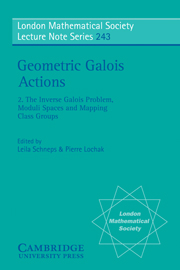Book contents
- Frontmatter
- Contents
- Introduction
- Abstracts
- Part I Dessins d'enfants
- Part II Inverse Galois problem
- Part III Galois actions, braids and mapping class groups
- Galois group Gℚ, singularity E7, and moduli M3
- Monodromy of iterated integrals and non–abelian unipotent periods
- Part IV Universal Teichmüller theory
- Errata for Tame and stratified objects
Galois group Gℚ, singularity E7, and moduli M3
Published online by Cambridge University Press: 04 May 2010
- Frontmatter
- Contents
- Introduction
- Abstracts
- Part I Dessins d'enfants
- Part II Inverse Galois problem
- Part III Galois actions, braids and mapping class groups
- Galois group Gℚ, singularity E7, and moduli M3
- Monodromy of iterated integrals and non–abelian unipotent periods
- Part IV Universal Teichmüller theory
- Errata for Tame and stratified objects
Summary
An Artin group is a generalization, defined for any graph, of the usual braid groups. The Artin group of E7 Dynkin diagram has a natural surjection to the mapping class group of genus three curves, defined by sending the canonical generators to a set of Dehn twists, called Humphries generators.
We first show that this group homomorphism comes from a geometric morphism between moduli spaces by taking π1.
Next, we describe the notion of tangential morphisms. Let U be an affine variety and D1,..., Dl be normal crossing divisors which are principal. The tangential morphism from D1∩ … ∩Dl to ∪ — (D1 ∪ … ∪ D l) is defined when we specify the generator of the defining ideal of Di for each i. This yields a morphism between the algebraic fundamental groups. A tangential morphism from a point Spec k coincides with the notion of k–rational tangential base point.
Using this, we describe the action of the absolute Galois group on the profmite completion of Artin groups of type An, Bn, Cn, Dn, and E7. (The first type gives the Braid group investigated before.) Description uses only the Belyi's coordinates, i.e. the action of the Galois group on the algebraic fundamental group of ℙ1 minus 0,1,∞.
As a corollary, we give an explicit description of the Galois action on the profinite completion of the mapping class group of genus 3 curve.
Information
- Type
- Chapter
- Information
- Geometric Galois Actions , pp. 179 - 218Publisher: Cambridge University PressPrint publication year: 1997
Accessibility standard: Unknown
Why this information is here
This section outlines the accessibility features of this content - including support for screen readers, full keyboard navigation and high-contrast display options. This may not be relevant for you.Accessibility Information
- 2
- Cited by
